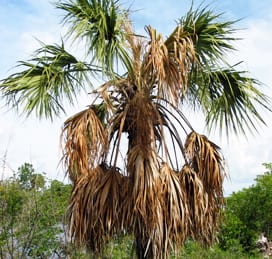A phytoplasma disease known as Texas Phoenix Palm Decline (TPPD) is killing many palm trees in both Texas and Florida and could spread elsewhere.
Introduction:
Texas Phoenix palm decline (TPPD) (Figs. 1-7) is a disease of palms that is caused by a phytoplasma (Harrison and Elliot 2009).
The phytoplasma is in the taxonomic group of organisms that produce lethal yellows or palm decline in palms (16 Sr-IV group of phytoplasmas). This group of organisms is vast and varied in host range and vector associations. TPPD was noticed initially in Corpus Christi, Texas in 2001 (Harrison et al. 2002) because decline symptoms were more common on Phoenix spp. than was expected for known U.S. phytoplasma diseases of palms. This disease now is known to cause decline in Phoenix sylvestris, Phoenix dactylifera, Phoenix canariensis, Phoenix roebelenii (Jeyaprakash et al. 2011), Sabal palmetto (Harrison and Elliot 2008; Harrison et al. 2009), and Syagrus romanzoffiana (Harrison et al. 2008). The entire host range of the pathogen is uncertain at this time. The disease first was noticed in Florida in the Ruskin area (Hillsborough County) in late 2006 and has been observed since then in Hillsborough, Manatee, Sarasota, Pinellas, Polk, Hardee, DeSoto, Highlands, Charlotte, Lee, Lake, Orange, Palm Beach, Indian River, Alachua and Duval counties (Fig. 8).
Description
The earliest symptom is a discoloration of the lower (oldest) leaves of the palms (Fig. 7). Discoloration begins at the tips of the leaflets. Subsequently, reproductive parts of the plant will die, resulting in dropping of fruits and flowers. In Phoenix palms, the spear leaf dies after approximately ¼ to ⅓ of the lower canopy has turned brown (Figs. 5, 6). In cabbage palms (Sabal palmetto), this may not occur. The disease can be difficult to recognize in the field, because nutritional problems (potassium deficiency, for example) and certain fungal diseases can look similar to the effects of the phytoplasma infection. If it is not the season for fruits and flowers, the diagnostic characteristics involving those parts cannot be used. In taller Phoenix palms, it can be difficult to impossible to see the spear leaf. Typically, infected cabbage palms will have at least the bottom ⅓ of the canopy dead and bronzed brown, and a much paler dead spear leaf (Fig. 1). A ring of leaves surrounding the spear leaf typically remains green for some time after the spear leaf dies (Fig. 4). Eventually, all the leaves collapse and fall, leaving the stem erect (Fig. 3).
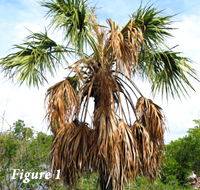
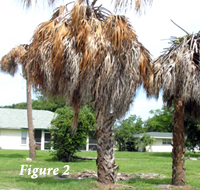
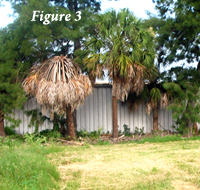
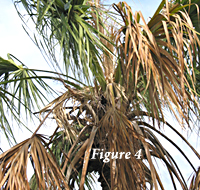
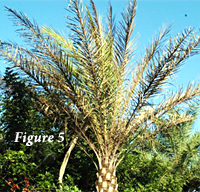
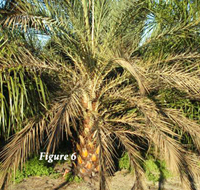
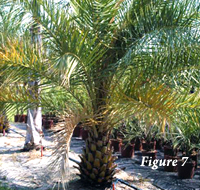
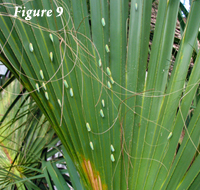
Transmission
The disease is thought to be transmitted by an insect vector, probably a planthopper (superfamily Fulgoroidea). The species is not known, but there are three species that are found routinely on palms in the areas where the disease is spreading (Halbert et al. 2014). One is a large flatid planthopper, Ormenaria rufifascia (Walker) (Fig. 9); another is a cixiid planthopper, Haplaxius crudus (Van Duzee) (Fig. 10); and the third one is a derbid planthopper, Omolicna joi Wilson et al. (Fig. 11).
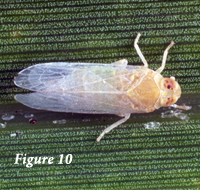
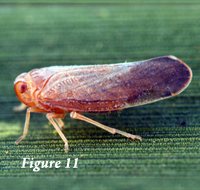
The cixiid is the known vector of lethal yellows in South Florida (Howard et al. 1983). It occurs throughout the Florida peninsula as far north as Gainesville and can be found during most of the year, but especially in the winter (Halbert et al. 2014). The derbid is known from Florida north of Broward and Collier counties. Flight activity is in the fall. The flatid is known from all of the Florida peninsula and is most abundant in the late spring.
Reporting and Sampling
Professionals and homeowners who suspect TPPD should contact their local IFAS County Extension Office. Telephone numbers and addresses can be found at the following website: http://solutionsforyourlife.ufl.edu/map/index.html. Samples can be sent to the Fort Lauderdale Research and Education Center.
Hosts
Phoenix sylvestris, Phoenix canariensis, Phoenix dactylifera, Phoenix roebelenii, Syagrus romanozoffiana and Sabal palmetto.
Distribution
Texas and Florida, USA.
Florida Distribution
Hillsborough, Manatee, Sarasota, Pinellas, Polk, Hardee, DeSoto, Highlands, Orange, Lake, Charlotte, Lee, Palm Beach, Alachua, Broward and Duval counties.
Article written by: Susan Halbert, Susan.Halbert@FreshFromFlorida.com,
Taxonomic Entomologist, Florida Department of Agriculture & Consumer Services, Division of Plant Industry.
Photos: Figures 1, 2, 3, 4, 8, & 9 by: Susan Halbert, FDACS-DPI.
Photos: Figures 5, 6 & 7 by: Monica Elliott, University of Florida, IFAS, Ft. Lauderdale.
Photos: Figure 10 by: David C. Ziesk
Photos: Figure 11 by: Lyle J. Buss, University of Florida.
View and download Florida Department of Agriculture complete artical


